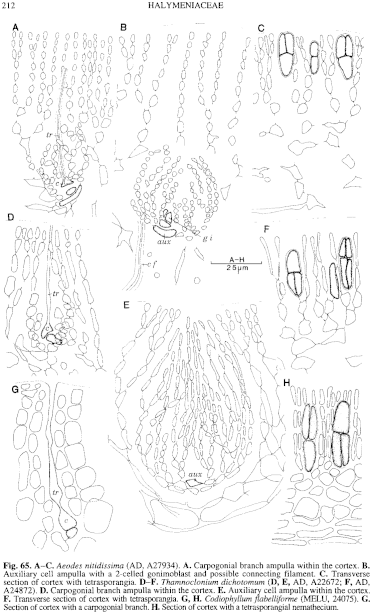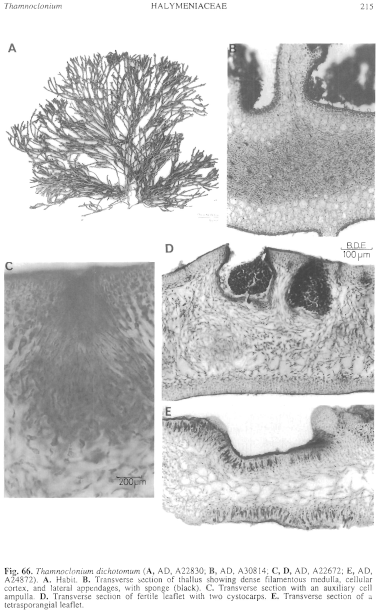|
|
|
|
|
|||||||||||
|
Electronic Flora of South Australia Species Fact Sheet
Phylum Rhodophyta – Class Florideophyceae – Order Gigartinales – Family Halymeniaceae
Selected citations: Chiang 1970: 62, figs 30, 31. DeToni 1905: 1615. Millar 1990: 329, fig. 12C, D. Scott, Wetherbee & Kraft 1984: 288, figs 1–9.
Synonyms
Polyphacum dichotomum J. Agardh 1841: 3.
Thamnoclonium hirsutum Kützing 1843: 392; 1849: 793; 1869: 17, pl. 47a-e. Harvey 1859b: 295; 1863: pl. 293. Sonder 1853: 696.
Thamnoclonium proliferum Sonder 1845: 56; 1848: 186. J. Agardh 1876: 169; 1879: 108, pl. 9 figs 8–12. De Toni 1905: 1616. Kützing 1849: 794; 1869: 17, pl. 47 f, g.
Thamnoclonium claviferum J. Agardh 1876: 168. Chapman & Parkinson 1974: 267. De Toni 1905: 1614.
Thamnoclonium codioides J. Agardh 1876: 168. De Toni 1905: 1615.
Thamnoclonium seminerve J. Agardh 1885: 18. De Toni 1905: 1616.
Thallus (Fig. 66A) dark brown-red, 10–30 cm high, cartilaginous, much branched irregularly to subdichotomously at intervals of (0.5–) 1–4 cm, branches linear, terete to compressed, 1–3 (–10) mm broad and 1.5–3 mm thick, covered throughout with short, irregularly branched excrescences and coated with a thin layer of sponge, often denuded near the base. Holdfast discoid-conical, 8–20 mm across; epilithic. Structure (Fig. 66B) of a pseudoparenchymatous cortex 50–120 µm and 4–7 cells thick, outer cells rounded, more or less isodiametric, 6–10 µm across, inner cells subspherical, reaching 20–30 µm across; medulla of dense and compact filaments, 20–60 µm across; refractive ganglionic cells absent. Secondary cortex present on lower axes with a surface meristem developing vertical rows of cells and up to 18 growth rings. Rhodoplasts laminate, discoid to elongate, few per cell, becoming ribbon shaped and branched in inner cells.
Reproduction: Reproductive structures borne in small, fertile leaflets clustered at the apices and upper margins or sometimes laterally, 2–5 (–8) mm long and 500–800 µm thick, irregularly lobed or flanged and smooth-surfaced (without sponge), and with a relatively lax filamentous medulla with some stellate cells.
Sexual thalli dioecious. Carpogonial branch ampullae (Fig. 65D) arising in inner cortex, with 3–6 erect secondary filaments each 2–8 cells long and a 2-celled carpogonial branch with a relatively robust trichogyne. Auxiliary cell ampullae (Figs 65E, 66C) in the inner cortex, with numerous secondary filaments of 4–8 (–12) elongate cells and occasional tertiary filaments (pre-fertilization), slightly converging above in the outer cortex, filaments reaching to the outer cortex of elongate cells. Carposporophytes (Fig. 66D) subspherical, compact, 120–200 µm across, usually crowded in the leaflets, with carposporangia ovoid to angular, 8–10 µm across; involucre prominent, developed by branching of the ampullary filaments; ostiole small. Spermatangia cut off from outer cortical cells, spermatia ovoid, 2–3 µm across.
Tetrasporangia (Figs 65F, 66E) in nemathecia on fertile leaflets, cut off from subsurface cells but with the surface cells dividing to form filaments of 2–3 elongate cells, 20–30 µm long and 7–10 µm in diameter, cruciately divided.
Type from "Nov. Ho11." (Sieber); lectotype in Herb. Agardh, LD, 23051; isolectotype in MEL, 606050. Sieber collected from the Sydney region, N.S.W., not in W. Aust. as stated by Chiang (1970, p. 62).
Selected specimens: Nichol Bay, W. Aust. (1880; MEL, 606031). Emu Beach, King George Sound, W. Aust., drift (Mitchell, 27.ix.1966; AD, A30814). "The Hotspot", W of Flinders I., S. Aust., 32 m deep (Brander?, 21.vi.1988; AD, A59298). Port Stanvac, S. Aust., 4 m deep (Clarke, 24.ii.1981; AD, A53964). Toad Head, West I., S. Aust., 16 m deep (Shepherd, 15.i.1966; AD, A30188). Kingston, S. Aust., drift (Womersley, 9.viii.1961; AD, A24872). Dutton Bay, Portland, Vic., drift (Womersley,
Distribution: Nichol Bay, W. Aust., to Richmond R. mouth, N.S.W., and around Tasmania.
Taxonomic notes: 13.iv.1959; AD, A22672) and 8–12 m deep on E side of breakwater (Kraft, 27.iv.1990; MELU, A40405). Queenscliff, Vic., drift (Womersley, 8.iv.1959; AD, A22830). Tortoise Head, French I., Western Port, Vic., 3 m deep (McCauley, 13.ii.1990; AD, A60206 -"Marine Algae of southern Australia" No.347). Crawfish Rock, Westernport Bay, Vic., 1 m deep (Goldsworthy, 14.ii.1990; AD, A60208). Gabo I., Vic., 28 m deep (Shepherd, 14.ii.1973; AD, A43349). Low Head, Tas. (Perrin, Sept. 1948; AD, A9053). Stapleton Point, Prosser Bay, Tas., 4–10 m deep (Shepherd, 10.ii.1970; AD, A35719). Jervis Bay, N.S.W., 20 m deep (Millar & Richards, 6.vi.1990; NSW, A9625). Jibbon Head, N.S.W. (Watson, Sept. 1976; MELU, A23393).
The types of T. hirsutum Kützing (from "Nov. Ho11." (Sieber) in L, isotype in MEL, 606048), T. proliferum Sonder [from W.Aust. (Preiss), holotype in MEL, 606057], T. claviferum J. Agardh [lectotype from Port Phillip, Vic. (Mueller), in Herb. Agardh, LD, 23047], T. codioides J. Agardh [from "Nov. Holl.", (Haswell), holotype in Herb. Agardh, LD, 23049] and T. seminerve J. Agardh [from Richmond R. mouth, N.S.W. (Hodgkinson), holotype in Herb. Agardh, LD, 23060] are all considered conspecific with T. dichotomum (Scott, Wetherbee & Kraft 1984, p. 288; Millar 1990, p. 329).
T. dichotomum (as T. proliferum) has been recorded from South Africa by Papenfuss (1968a, p. 283), who considered T. latifrons Endlicher & Diesing was conspecific. Norris (pers. comm. in Scott, Wetherbee & Kraft 1984, p. 288) apparently considers T. latifrons to be a distinct species.
References:
AGARDH, J.G. (1841). In historiam algarum symbolae. Linnaea 15, 1–50, 443–457.
AGARDH, J.G. (1876). Species Genera et Ordines Algarum. Vol. 3, Part 1 - Epicrisis systematis Floridearum, pp. i-vii, 1–724. (Weigel: Leipzig.)
AGARDH, J.G. (1879). Florideernes morphologi. K. Svenska Vetensk. Akad. Handl. 15(6), 1–199, Plates 1–33.
AGARDH, J.G. (1885). Till algemes systematik. VII. Florideae. Acta Univ. lund. 21, 1–120, Plate 1.
CHAPMAN, V.J. & PARKINSON, P.G. (1974). The marine algae of New Zealand. Part DI: Rhodophyceae. Issue 3: Cryptonemiales. (Cramer: Germany.)
CHIANG, Y.-M. (1970). Morphological studies of red algae of the family Cryptonemiaceae. Univ. Calif Pubis Bot. 58, 1–83, Plates 1–10.
DE TONI, G.B. (1905). Sylloge Algarum omnium hucusque Cognitarum. Vol. 4. Florideae. Sect. 4, pp. 1523–1973. (Padua.)
HARVEY, W.H. (1859b). Algae. In Hooker, J.D., The Botany of the Antarctic Voyage. Flora Tasmaniae. Vol. II, pp. 282–320.
HARVEY, W.H. (1863). Phycologia Australica. Vol. 5, Plates 241–300, synop., pp. i-lxxiii. (Reeve: London.)
KÜTZING, F.T. (1843). Phycologia generalis. (Leipzig.)
KÜTZING, F.T. (1849). Species Algarum. (Leipzig.)
KÜTZING, F.T. (1869). Tabulae Phycologicae. Vol. 19. (Nordhausen.)
MILLAR, A.J.K. (1990). Marine Red Algae of the Coffs Harbour Region, northern New South Wales. Aust. Syst. Bot. 3, 293–593.
PAPENFUSS, G.F. (1968a). Notes on South African Marine Algae: V. J. S. Afr. Bot. 34, 267–287.
SCOTT, F.J., WETHERBEE, R. & KRAFT, G.T. (1984). The morphology and development of some prominently stalked southern Australian Halymeniaceae (Cryptonemiales, Rhodophyta). B. The sponge-associated genera Thamnoclonium Kützing and Codiophyllum Gray. J. Phycol. 20, 286–295.
SONDER, O.G. (1845). Nova Algarum genera et species, quas in itinere ad oras occidentales Novae Hollandiae, collegit L. Preiss, Ph.Dr. Bot. Zeit. 3, 49–57.
SONDER, O.W. (1848). Algae. In Lehmann, C., Plantae Preissianae. Vol. 2, pp. 161–195. (Hamburg.)
SONDER, O.W. (1853). Plantae Muellerianae. Algae. Linnaea 25, 657–709.
The Marine Benthic Flora of Southern Australia Part IIIA complete list of references.
Publication:
Womersley, H.B.S. (14 January, 1994)
The Marine Benthic Flora of Southern Australia
Rhodophyta. Part IIIA, Bangiophyceae and Florideophyceae (to Gigartinales)
Reproduced with permission from The Marine Benthic Flora of Southern Australia Part IIIA 1994, by H.B.S. Womersley. Australian Biological Resources Study, Canberra. Copyright Commonwealth of Australia.
Illustrations in Womersley Part IIIA, 1994: FIGS 65 D–F, 66.

Figure 65 enlarge
Fig. 65. A–C. Aeodes nitidissima (AD, A27934). A. Carpogonial branch ampulla within the cortex. B. Auxiliary cell ampulla with a 2-celled gonimoblast and possible connecting filament. C. Transverse section of cortex with tetrasporangia. D–F. Thamnoclonium dichotomum (D, E, AD, A22672; F, AD, A24872). D. Carpogonial branch ampulla within the cortex. E. Auxiliary cell ampulla within the cortex. F. Transverse section of cortex with tetrasporangia. G, H. Codiophyllum flabelliforme (MELU, 24075). G. Section of cortex with a carpogonial branch. H. Section of cortex with a tetrasporangial nemathecium.

Figure 66 enlarge
Fig. 66. Thamnoclonium dichotomum (A, AD, A22830; B, AD, A30814; C, D, AD, A22672; E, AD, A24872). A. Habit. B. Transverse section of thallus showing dense filamentous medulla, cellular cortex, and lateral appendages, with sponge (black). C. Transverse section with an auxiliary cell ampulla. D. Transverse section of fertile leaflet with two cystocarps. E. Transverse section of a tetrasporangial leaflet.

|
Email Contact: State Herbarium of South Australia |

|